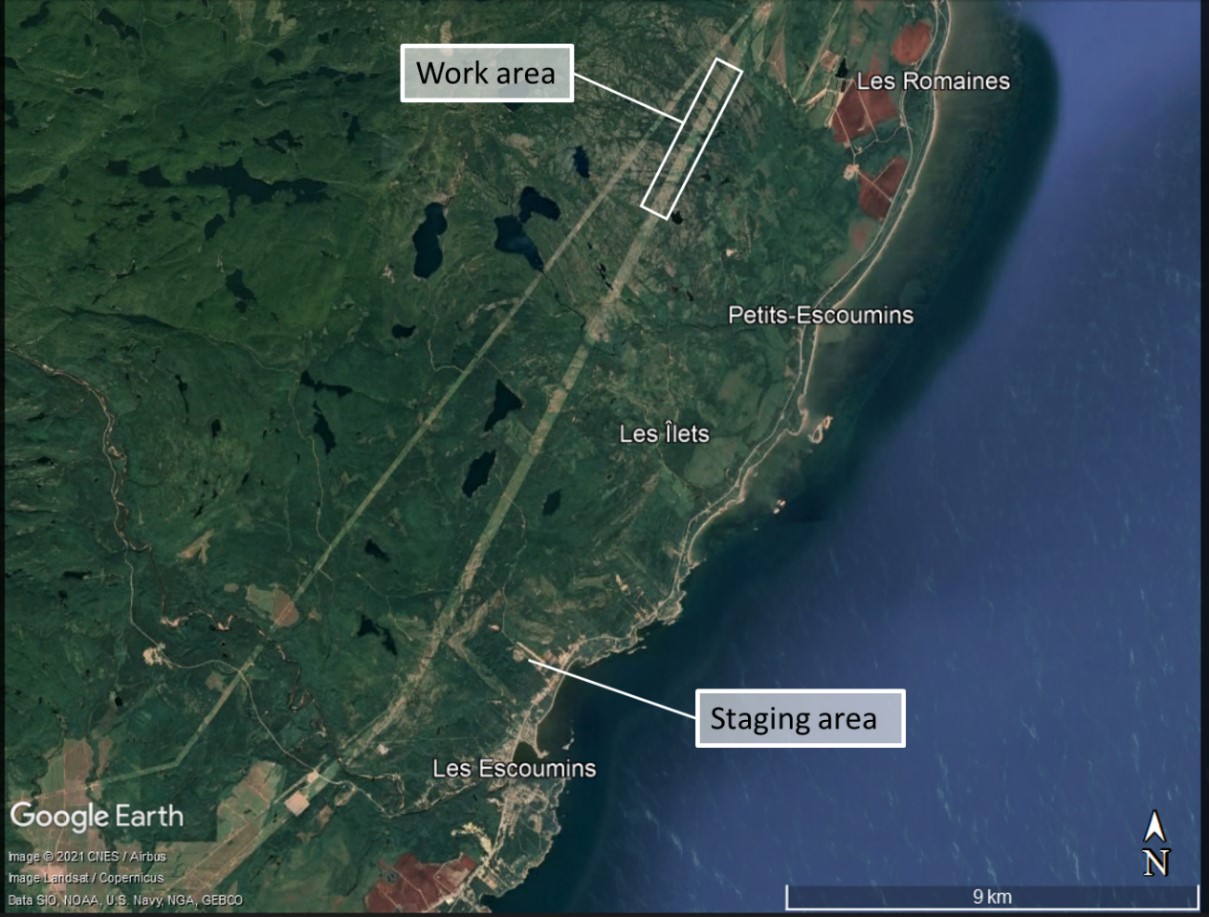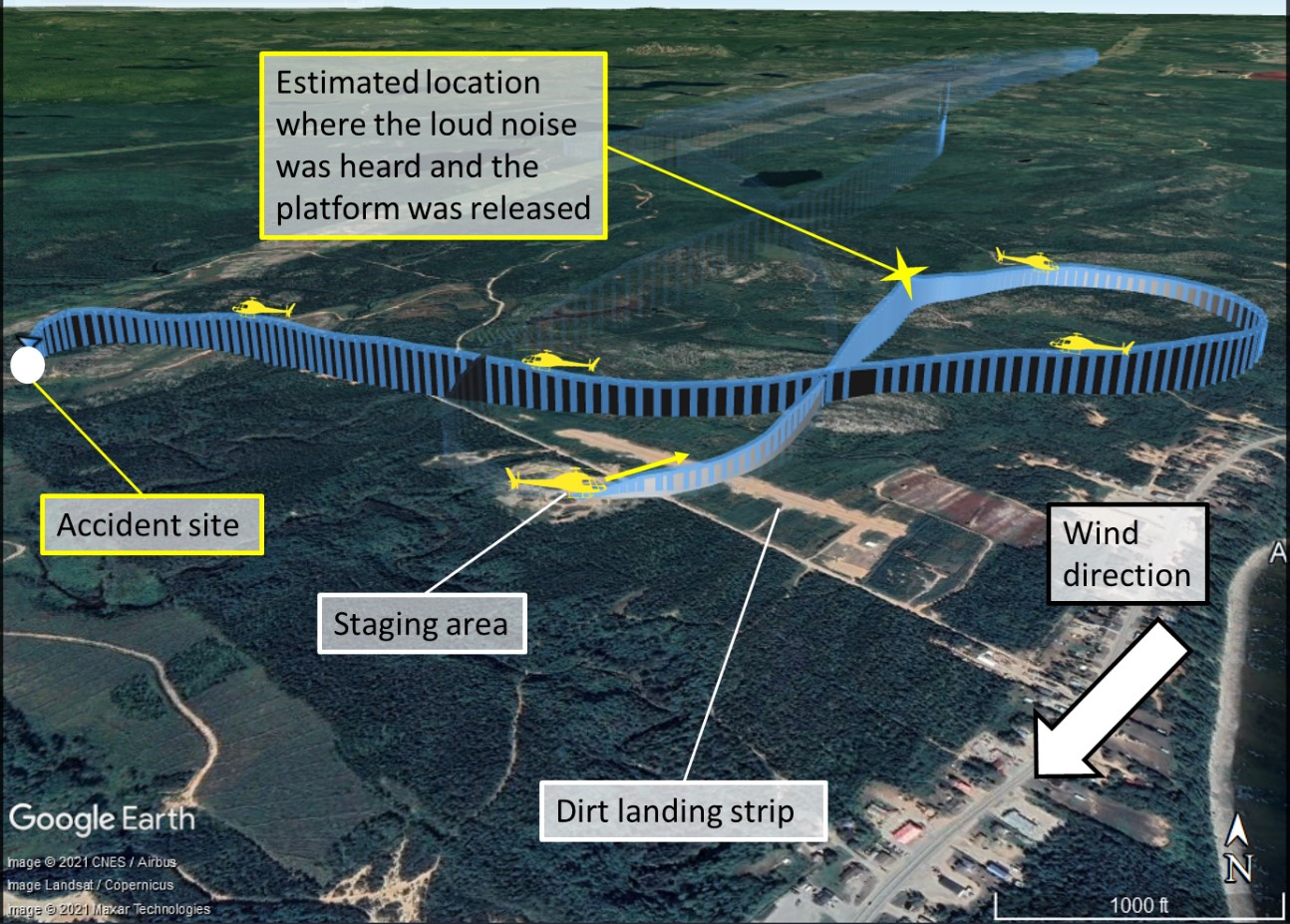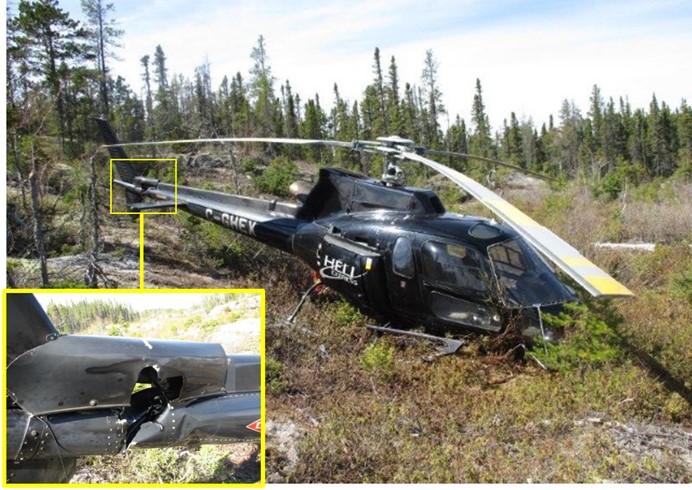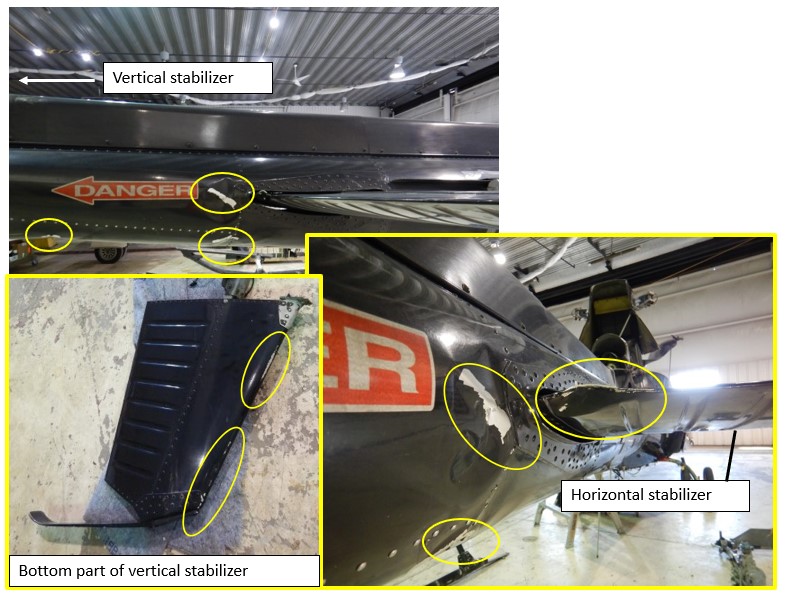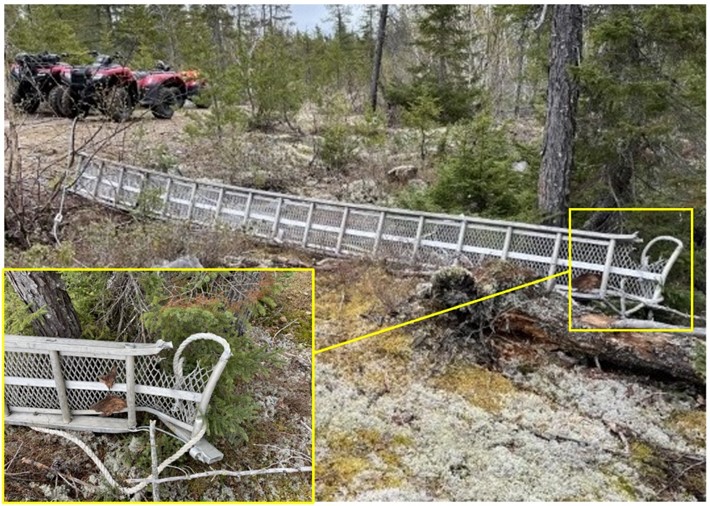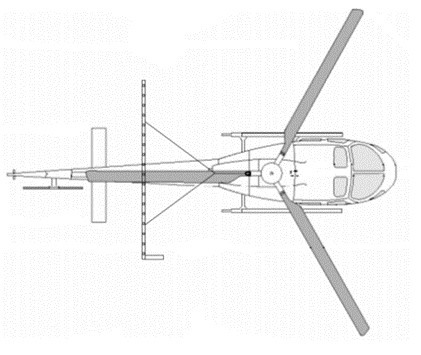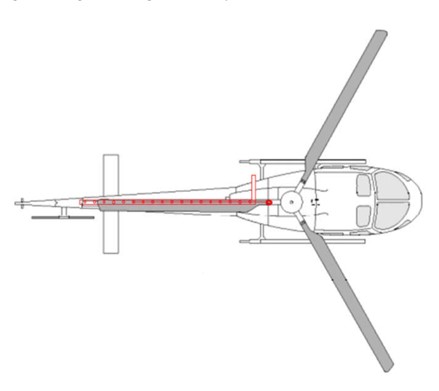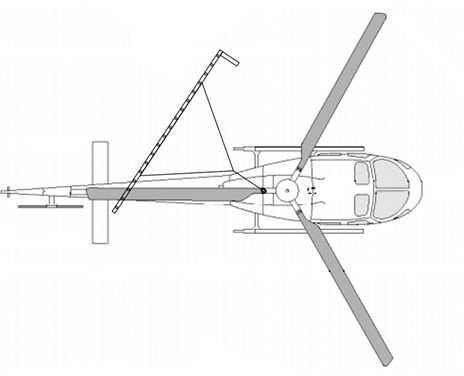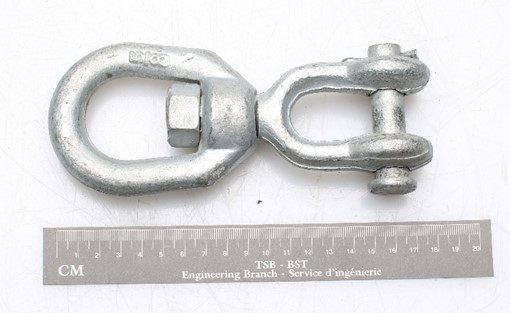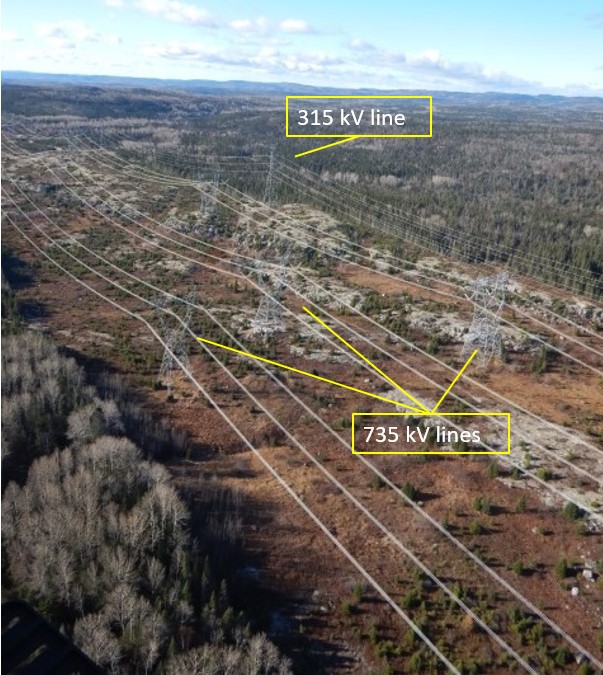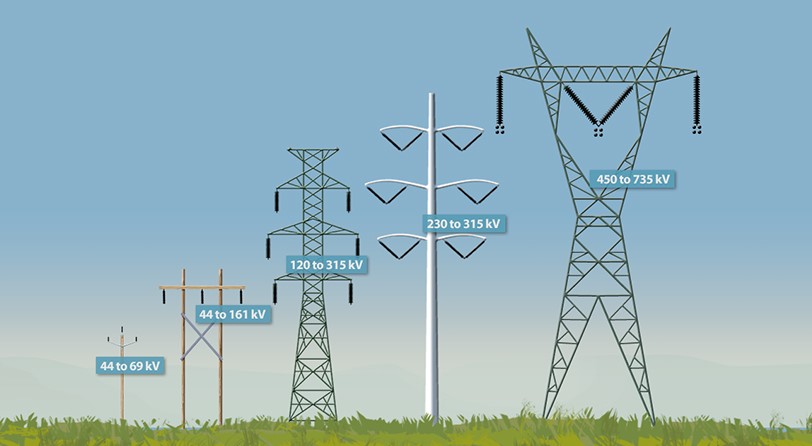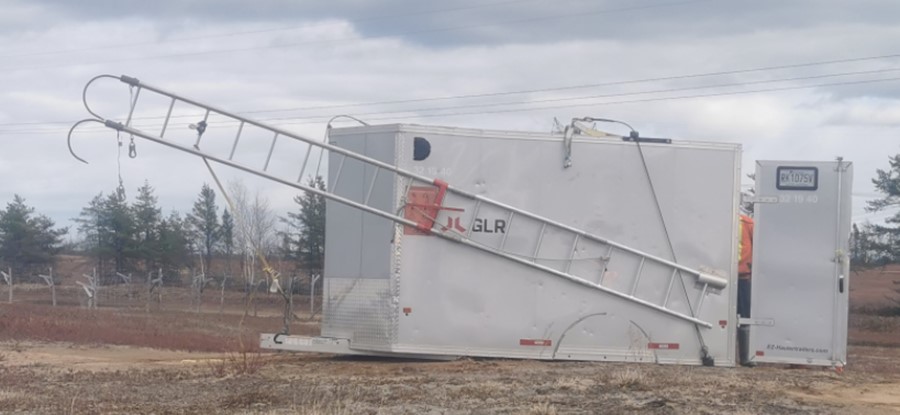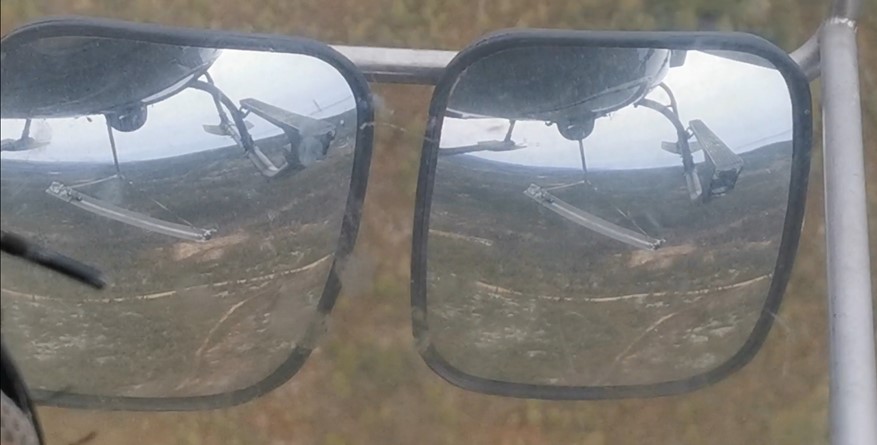Collision between sling load and tail rotor
Héli-Express Inc.
Airbus AS350 B2 (helicopter), C-GHEX
Les Escoumins, Quebec, 1.5 NM NNE
The Transportation Safety Board of Canada (TSB) investigated this occurrence for the purpose of advancing transportation safety. It is not the function of the Board to assign fault or determine civil or criminal liability. This report is not created for use in the context of legal, disciplinary or other proceedings. See Ownership and use of content. Masculine pronouns and position titles may be used to signify all genders to comply with the Canadian Transportation Accident Investigation and Safety Board Act (S.C. 1989, c. 3).
Summary
On 11 May 2021, the Héli-Express Inc. Airbus AS350 B2 helicopter (registration C-GHEX, serial number 2867) was conducting flights to carry workers and equipment from a staging area to a work area at a 315 kV transmission line located northeast of Les Escoumins, Quebec.
Shortly after taking off from the staging area with a platform hanging from the cargo hook mounted on the belly of the helicopter, the pilot heard a loud noise. He released the external load, and almost immediately, the helicopter yawed strongly to the left. The pilot turned 180° to make an emergency landing on a dirt landing strip not far from the staging area. During the approach, the pilot experienced great difficulty controlling the aircraft’s yawing motion to the left. When he was no longer able to control the yaw, he shut down the engine and the aircraft landed hard in an upright position on rugged terrain. The aircraft remained in an upright position and was substantially damaged, but there was no post-impact fire.
The emergency locator transmitter activated, and the signal was detected by the Canadian Mission Control Centre in Trenton, Ontario. Although the pilot was severely injured, he was able to get out of the aircraft and call the site manager to report the accident. Another helicopter that was working at the same site flew to the accident site and dropped off a nurse. The injured pilot was transported to hospital in Chicoutimi, Quebec.
1.0 Factual information
1.1 History of the flight
On 11 May 2021, 2 Héli-Express Inc. (Héli-Express) Airbus AS350 B2 (AS350) helicopters were scheduled to carry workers and equipment for G.L.R. Inc. (GLR) from a staging area to a work area at a Hydro-Québec 315 kV transmission line located northeast of Les Escoumins (Figure 1).
In the morning, before beginning the day’s flights, the 2 Héli-Express pilots held their daily safety meeting with the site manager and all of the workers before flying the various teams to their respective work sites.
At approximately 0915,Footnote 1 a work platform being used by one of the teams of line workers was damaged. The site manager was notified; he radioed the pilots of the 2 helicopters, who were in flight, to inform them that a replacement platform was ready to be slung from the staging area to the team waiting for it. The pilot of the first helicopter available (registration C-GHEX, serial number 2867) flew to the staging area, where he landed to refuel. The loadmaster checked that the straps were properly fastened to the platform, in accordance with the instructions he had received. Once refuelling was complete, the pilot brought the helicopter into a hover over the platform, and the loadmaster attached it horizontally, directly to the cargo hook mounted on the belly of the helicopter, as he had done previously.
When the helicopter took off with the load, the loadmaster noticed that it was swinging back and forth and notified the pilot by radio. The pilot, who had noticed on previous flights that the load would begin to swing after takeoff and would stabilize when the helicopter accelerated, confirmed that he saw the load in his mirrors and continued to climb and accelerate.
Shortly thereafter, the pilot heard a loud noise while the helicopter was approximately 350 feet above ground level, travelling at a speed of 65 knots. The pilot immediately slowed down and opened the hook to jettison the platform. At about the same time, the helicopter experienced a strong yawFootnote 2 to the left that the pilot was unable to control with the anti-torque pedals,Footnote 3 even with full application of the right pedal. The pilot then accelerated to attempt to maintain control of the yawing helicopter.
After getting the yaw under control, the pilot turned 180° to the right to fly to a dirt landing strip not far from the staging area and conduct an emergency landing. The pilot radioed the line workers on the ground to report that he had a problem with the tail rotor and was going to conduct an emergency landing. At that point, the pilot believed that a break had occurred along the tail rotor control system, causing the pitch control to stop responding after he heard the loud noise.
The pilot of the second helicopter, who was airborne at the time, heard the radio message and left his work area, heading to the staging area, where the site manager and loadmaster were standing.
After doing the 180° turn, the occurrence helicopter was downwind. The left yaw then increased and quickly made it more difficult to control the helicopter. The pilot lost control of the yawing helicopter twice, but he was able to regain control by increasing speed and reducing power, which in turn caused the helicopter to lose altitude. During a 3rd loss of control, the pilot deemed the altitude and speed to be too low to regain control in the air. He then manoeuvred to reduce his speed and altitude as much as possible before shutting down the engine to stop the spin. At approximately 1033, the helicopter landed hard in an upright position on rugged terrain in a sparsely wooded area. The force of the impact activated the emergency locator transmitter, and the signal was detected by the Canadian Mission Control Centre in Trenton, Ontario, at 1042.
The pilot called the site manager to report the accident. The second helicopter, which had landed at the staging area, flew to the accident site with a nurse and a stretcher on board. The injured pilot was transported to hospital in Chicoutimi, Quebec.
1.2 Injuries to persons
The pilot was alone on board the helicopter.
| Degree of injury | Crew | Passengers | Persons not on board the aircraft | Total by injury |
|---|---|---|---|---|
| Fatal | 0 | – | – | 0 |
| Serious | 1 | – | – | 1 |
| Minor | 0 | – | – | 0 |
| Total injured | 1 | – | – | 1 |
1.3 Damage to aircraft
The aircraft was substantially damaged, but there was no post-impact fire.
1.4 Other damage
Not applicable.
1.5 Personnel information
| Pilot licence | Commercial pilot licence – Helicopter |
|---|---|
| Medical expiry date | 01 June 2022 |
| Total flying hours | 3185 |
| Flight hours on type | 1465 |
| Flight hours with sling load | 211 |
| Flight hours in the 7 days before the occurrence | 22.3 |
| Flight hours in the 30 days before the occurrence | 73.4 |
| Flight hours in the 90 days before the occurrence | 96.9 |
| Hours on duty before the occurrence | 4 |
| Hours off duty before the work period | 10 |
The pilot, who had been working for Héli-Express since 2018, held a commercial pilot licence – helicopter and a valid Category 1 medical certificate. He held a night rating and Class 3 flight instructor rating. His pilot proficiency check was valid until 01 January 2022. The pilot held the appropriate licence and ratings for the occurrence flight in accordance with existing regulations.
The pilot had been assigned this contract on 25 April 2021 after a 14-day rest period. According to information gathered, there was no indication that fatigue contributed to the occurrence.
1.6 Aircraft information
| Manufacturer | Eurocopter* |
|---|---|
| Type, model and registration | AS350 B2, C-GHEX |
| Year of manufacture | 1995 |
| Serial number | 2867 |
| Certificate of airworthiness/flight permit issue date | 11 May 2001 |
| Total airframe time | 12 897 (approximately) |
| Engine type (number of engines) | Turbomeca Arriel 1D1 (1) |
| Rotor type (number of blades) | Semi-rigid (3) |
| Maximum allowable take-off weight | 4961 lb (2250 kg) |
| Recommended fuel type(s) | Jet A, Jet A-1, Jet B, JP4, JP5, JP8 |
| Fuel type used | Jet A-1 |
* Eurocopter became Airbus Helicopters in 2014.
Technical records indicated that the last 100-hour inspection had been completed on 07 May, 4 days before the occurrence. The helicopter had flown approximately 9.5 hours since returning to service (the day of the inspection) and no anomalies were detected.
The pre-flight inspection conducted on the day of the occurrence included 5 airworthiness directives Footnote 4 applicable to the helicopter, 4 of which were related to the tail rotor.
There was no indication that an aircraft system or component malfunction contributed to this occurrence.
1.7 Meteorological information
At 1000 on the day of the occurrence, the Grandes-Bergeronnes automatic weather station, located 10 nautical miles (NM) southwest of the accident site, reported winds from the northeast at approximately 8 knots, a temperature of 9 °C and a dew point of 0 °C.
Weather conditions were suitable for visual flight rules flight, and there was no indication that they were a factor in this occurrence.
1.8 Aids to navigation
Not applicable.
1.9 Communications
Not applicable.
1.10 Aerodrome information
Not applicable.
1.11 Flight recorders
The aircraft was not equipped with a flight data recorder or a cockpit voice recorder, nor was either required under existing regulations.
The helicopter did, however, have a satellite flight tracking system, and the pilot was using a personal GPS (global positioning system), from which it was possible to retrieve data. The GPS recorded the aircraft’s GPS position, altitude, and ground speed (Figure 2).
1.12 Wreckage and impact information
The aircraft made a hard landing on rugged terrain with sparse patches of low vegetation. It was found standing on its skids. The landing gear had collapsed and was deformed by the force of the impact (Figure 3).
The tail rotor and gearbox were missing from the end of the tail boom. The right horizontal stabilizer was curved at the trailing edge, near the tail boom, over approximately 4 inches. Also, impact marks and scratches were visible in several locations along the right side of the tail boom, between the horizontal stabilizer and vertical stabilizer, and along the bottom part of the leading edge of the vertical stabilizer (Figure 4).
The tail rotor and gearbox were found approximately 70 feet from where the platform fell after it was released by the pilot. The platform was found to be substantially damaged at one end. The lifting straps were still attached (Figure 5).
1.12.1 Examination of the platform and tail rotor
The tail rotor and gearbox, along with the platform and lifting straps, were sent to the TSB Engineering Laboratory in Ottawa, Ontario, for further examination.
The platform (model LG18, serial number C17-C15-8-1) had been manufactured in March 2021 in accordance with engineering drawings designed to meet GLR’s needs. It was approximately 18 feet long and weighed approximately 121 pounds. The damage to one end was caused by the impact of an object hitting it from underneath.
An analysis of the marks observed on the leading edge of one of the tail rotor blades confirmed that it hit the platform in an upward motion.
The distance measured between the cargo hook mounted on the belly of the helicopter and the end of a tail rotor blade at its closest point to the hook was 197.7 inches.Footnote 5 To determine whether the platform could come into contact with the end of a tail rotor blade while it was hooked up and being carried as it was in this occurrence, several factors were taken into consideration, including the drag Footnote 6 and speed at which the helicopter was travelling (estimated to be 65 knots) when the pilot heard the loud noise.
Figure 6 shows a configuration where the platform is perpendicular to the helicopter’s longitudinal axis, with the strap attachment points on the platform perfectly symmetrical. According to calculations, in this configuration, the maximum distance that could be reached by any part of the platform is 128 inches from the cargo hook. The configuration assumes symmetrical drag factors, which was not the case for the occurrence platform. It was found attached asymmetrically (one strap was attached 51 inches from the tip, the other 39 inches from the other tip). Therefore, the symmetrical configuration shown in Figure 6 would not be representative of the typical flight attitude of the occurrence platform.
Figure 7 shows a configuration where the platform is on the helicopter’s longitudinal axis. According to calculations, in this configuration, the maximum distance that could be reached by any part of the platform is 200 inches from the cargo hook. Knowing that the damage was approximately 10 inches from the tip of the platform, the distance between the cargo hook and the damage was estimated to be 190 inches. This configuration is unlikely because it was determined that extreme instability and aerodynamic drag imbalance would have been required for the platform to be in this position. Nevertheless, this configuration was examined, because it represents the theoretical maximum reach of the platform behind the cargo hook.
Figure 8 shows a configuration where the platform is at an angle (approximately 40° to the tail rotor disk) to the helicopter’s longitudinal axis. This configuration is the most probable based on the test carried out in flight before the occurrence. In this configuration, the 2 straps are held taught by the tension of the aerodynamic load. According to calculations, in this configuration, the maximum distance that could be reached by any part of the platform is 170 inches. Knowing that the damage was approximately 10 inches from the tip of the platform, and taking into account the angle, the distance between the cargo hook and the damage was estimated to be 164 inches.
These 3 configurations assume that the platform is parallel to the horizontal plane, which was not the case in this occurrence. By applying all the factors (drag, helicopter speed, etc.), it was estimated that the closest the platform would have been to horizontal was 24° to the horizontal plane of the helicopter, as it would have been in the first configuration (perpendicular platform, shown in Figure 6).
The impact marks on the tail rotor indicate the direction from which the damage was caused. The deformation of the platform clearly shows that the tail rotor struck the underside of the platform at an angle of approximately 40° to the tail rotor’s plane of rotation. When the damage is looked at as a whole, for the damage to the platform to be possible, the platform must have been oriented approximately 40° to the direction of flight and offset to the left, which corresponds to the configuration shown in Figure 8.
However, as demonstrated by the calculations made for this configuration (40° angle), direct contact with one of the tail rotor blades was impossible when the platform was suspended from the cargo hook.
1.12.2 Swivel
The swivel used in helicopter operations is a pivoting connector designed for lifting. It is attached either between the sling and the load or between the cargo hook mounted on the belly of the helicopter and the sling. No load is ever totally stable when it is being carried by a helicopter, and it can be difficult to predict its behaviour during flight. The swivel enables the load to pivot freely without twisting the sling. The sling’s twisting can destabilize the load and degrade the sling (which is under tensile forces), which could have a negative impact on flight safety.
The Crosby G-403 jaw end swivel (Figure 9) used to carry the occurrence platform was designed for cable pulling (to roll out electrical wiring when installing a line above ground or underground, for example), not for lifting a load.Footnote 7 To determine whether this particular swivel allowed the platform to pivot in flight, the TSB laboratory carried out a torque testFootnote 8 on different loads. A load of 82 pounds produced little friction and allowed the swivel to pivot freely (with no force necessary), while a load of 246 pounds required torque of 4.5 foot-pounds to overcome the friction between the 2 parts that make up the swivel and enable a pivoting motion. The test revealed that the torque value increased rapidly with the weight of the load. The 2 surfaces of the swivel making contact at the pivoting point were not smooth and did not have an equal and predictable amount of resistance over 360°.Footnote 9
The platform’s tension load while moving in the air at a speed of 65 knots was assessed at 268 pounds.Footnote 10 Given the positioning of the straps found on the platform and the drag experienced by the platform while airborne, an imbalance could be expected. Under these conditions, the torque produced by the aerodynamic forces was from 7.5 to 10 times greater than what was needed to pivot the platform. Consequently, it is highly likely that the platform turned or swung during the occurrence flight.
1.13 Medical and pathological information
According to information gathered during the investigation, there was no indication that the pilot’s performance was degraded by medical or physiological factors.
1.14 Fire
There were no signs of fire.
1.15 Survival aspects
The aircraft had an emergency locator transmitter that functioned as designed, transmitting a distress signal on frequency 406 MHz, along with the aircraft’s last reported GPS position.
The pilot was wearing a flight helmet even though Héli-Express does not require their pilots to wear one during flight operations. The pilot was also wearing a 4-point harness.
1.16 Tests and research
1.16.1 TSB laboratory reports
The TSB completed the following laboratory report in support of this investigation:
- LP066/2021 – Sling Load Contact
1.17 Organizational and management information
1.17.1 Hydro-Québec
Hydro-Québec is a public utility that manages the generation, transmission and distribution of electricity in Quebec, as well as the construction of associated infrastructure. It had over 20 000 permanent and temporary employeesFootnote 11 at the end of 2020. It has 3 divisions:
- Hydro-Québec Production [Production];
- Hydro-Québec TransÉnergie et Équipement [TransEnergy and Equipment];
- Hydro-Québec Distribution et Services partagés [Distribution and Shared Services].Footnote 12
The Direction – Services de transport [Transportation Services Branch], which is part of the Centre de services partagés, is responsible for managing Hydro-Québec’s aircraft fleet, charters (airplanes and helicopters), remotely piloted aircraft systems and flight following, among other things. It is also responsible for overseeing and supervising flight safety during operations, which includes surprise inspections at work sites.
The TransÉnergie et Équipement division is responsible for the network of transmission lines, which extends over more than 34 000 km. Given that Hydro-Québec does not own any helicopters, it relies on the services of Quebec helicopter companies to fulfill its responsibilities over its vast network, thereby creating many jobs.
Maintenance of existing transmission lines is normally carried out by Hydro-Québec employees, while transmission line construction and modification are carried out by specialized transmission line construction contractors hired by Hydro-Québec. The investigation determined that because of Hydro-Québec’s limited in-house capacity to perform insulator replacement on its extensive network of transmission lines, it must rely on specialized contractors to perform this maintenance work, as was the case in this occurrence.
The TransÉnergie et Équipement division schedules and determines what is needed for insulator replacement work. Schedules are fixed for this type of work because it requires a temporary shutdown of the power circuit being worked on.
The division prepares the documentation specific to the planned work and sends it to the Direction principale - Approvisionnement stratégique [Strategic Procurement Department](DPAS), which posts the requests for proposals and awards the contracts. For work such as this, the requests for proposals are open only to suppliers who have been prequalified by Hydro-Québec.
The supplier qualification process allows Hydro-Québec to identify suppliers who, in its opinion, have the financial capability, material and human resources, expertise, and authorizations necessary to perform the work. Hydro-Québec may also verify the qualification by auditing qualified suppliers to ensure that they continue to meet the qualification criteria.Footnote 13
Since 01 January 2019, suppliers performing “qualified” contracts (i.e., contracts requiring supplier prequalification) have been subject to a performance evaluation process. This evaluation has 3 performance indicators: quality of goods and services (30%); ability to meet contractual commitments (including meeting deadlines), and occupational health and safety (60%); and the business relationshipFootnote 14 (10%). After the evaluation, a performance rating is assigned to each supplier for all contracts completed in a given year. The next year, Hydro-Québec uses this rating as a weighting factor, increasing or decreasing the value of compliant bids for a new request for proposals so that bids can be compared and Hydro-Québec can determine which is the lowest bidder (i.e., offering the lowest priceFootnote 15). Hydro-Québec also reserves the right to negotiate the price while reviewing compliant bids.
In this occurrence, GLR was evaluated based on its performance at the Les Escoumins work site, and had to meet several deadlines in submitting documentation and in performing the work on the transmission lines. Missing any deadlines or dates indicated in the contract would lower its performance rating, and it could face a monetary penalty per tower if the insulator replacement was not completed by the date stipulated in the contract.
1.17.1.1 Specific clauses
Any specific clauses to be included in a contract are determined by the division in charge of work planning—in this case, the Équipement group in the TransÉnergie et Équipement division—and then sent to DPAS. The clauses include specific instructions to meet particular needs such as flight operations.
Most transmission line insulators are replaced using helicopters. When the work is performed under contract, it is up to the supplier who is awarded the contract to decide whether or not to use the services of an air operator. If it does, the supplier must choose an air operator prequalified by Hydro-Québec to work at its sites.
As the holder of the contract with Hydro-Québec, the supplier is responsible for communicating the specific clauses of the contract to the air operator chosen, and ensuring that the clauses are understood and met.
The Direction – Services de transport, which manages all aspects of Hydro-Québec’s flight operations, should be notified of any incident that could affect the safety of flight operations so that corrective action can be taken as necessary and communicated to operators. However, the Direction – Services de transport is not kept informed of flight operations when the air operator is a subcontractor, and is therefore unable to implement corrective action and communicate with such operators.
In this occurrence, Héli-Express did not receive the documentation describing the specific clauses related to flight operations. Qualified air operators are already aware of many of these clauses given that they are included in Hydro-Québec’s qualification requirements. However, according to information gathered during the investigation, some air operators are not sure if Hydro-Québec’s requirements apply regardless of whether they are hired directly by Hydro-Québec or through a supplier.
1.17.2 GLR
GLR specializes in the construction of overhead power transmission networks and works exclusively, or almost exclusively, for Hydro-Québec. The company has approximately 30 permanent employees, and depending on the projects in progress, may have up to about 300 employees. It conducts operations all year round, but most are carried out from April to October. GLR is one of the 11 suppliers qualified by Hydro-QuébecFootnote 16 for contracts relating to the construction of transmission lines.Footnote 17
In this occurrence, GLR was awarded the contract for the replacement of 315 kV transmission line insulators spread throughout several administrative regions, including Côte-Nord The section of transmission line requiring work was located near 3 parallel 735 kV high-voltage transmission lines (Figure 10).
The contract for replacing insulators on a 315-kV transmission line was the first contract of this nature for GLR. The company had already completed several insulator replacement contracts, but those were on 735 kV transmission lines (see section 1.17.3.2 Contract performance for more details on this type of transmission line).
1.17.2.1 Hydro-Québec contract
The time between a contract being awarded by Hydro-Québec and the start of work is on average 40 days, but frequently it is 14 days. According to information gathered, suppliers complain that this is often too short an interval to properly prepare for the work, putting additional pressure on them. In addition to having to prepare the documentation required by Hydro-Québec (working methods, etc.), suppliers may encounter problems hiring enough qualified workers, obtaining the required materials in time, and preparing the work area. The limited availability of certain equipment and the lack of qualified workers are often obstacles that suppliers must overcome within the timeframes stipulated in the contract, without the possibility of an extension. According to information gathered during the investigation, suppliers regularly bring this timeline issue to the attention of DPAS.
According to its contract, GLR was responsible for the following tasks:
- supplying labour, machinery, and certain materials
- deforestation as necessary
- transporting material from where it was available to where it was needed for work purposes
- site rehabilitation after work was completed
Hydro-Québec did not allow GLR to use its depot or buildings as staging areas. GLR had to find sites along the transmission line and rent construction trailers that could be moved periodically as work progressed.
GLR and Héli-Express had only 14 days to prepare for the work from when the contract was awarded to when work began.
1.17.2.2 Working methods
In the context of contracts performed for Hydro-Québec, a working method is a document prepared by a qualified engineer who has a minimum number of years of experience in the construction and repair of transmission lines. The document details the steps to be taken to perform the work. It also highlights any hazards and risks associated with the work, and the safety measures to be followed. Generally speaking, working methods are reference documents for the work to be performed by line workers.
The number of working methods required depends on the type of work site. For example, a traditional transmission line construction site may require 40 to 50 working methods. The occurrence site had 12 working methods.
It is up to the supplier to establish the working methods and submit them to Hydro-Québec for comment and approval by a set date. Every working method is signed by one or more representatives of Hydro-Québec (occupational health and safety, environment, or site manager) as appropriate.
Once Hydro-Québec has agreed to the supplier’s working methods, the supplier must communicate them to workers and subcontractors, as applicable, before work begins, and to each new worker or subcontractor thereafter. A signature log is kept to document that the working methods have been distributed and understood. The supplier may modify working methods as necessary but must notify Hydro-Québec, as well as workers and subcontractors, of the changes made. Hydro-Québec may also [translation] “stop work at any time if it deems that a working method is not being followed or if any new uncontrolled hazards or risks arise while work is being performed.”Footnote 18
1.17.2.2.1 Working method for sling operations
When sling operations are planned, the supplier must prepare a working method that covers sling operations and hooking up loads for ground workers who are in charge of preparing loads. In this occurrence, this working method was not a procedure meant for the pilot on how to sling a load or the type of sling to be used. It did, however, include a “hold point,” or a pause in operations, in case a new situation or one not covered by the working method arose. The purpose of the hold point is to give time to think about and decide on an action, and can lead to changing the initial working method, if necessary.
In reviewing and approving the sling working methods, Hydro-Québec does not consult the Direction – Services de transport. Employees who review the working methods may not be familiar with the preparation of sling loads.
In this occurrence, GLR’s working method included the following information:
- images of known loads to be transported near hydro towers
- methods for securing known loads
- sling material provided (straps, swivels) and how to use it
- communication signals to be used with the pilot
To prepare its sling working method, GLR used as templates the relevant working methods that Hydro-Québec had approved for insulator replacement contracts on 735 kV transmission lines that had been carried out by Héli-Express in the past. GLR did not consult Héli-Express, but rather used its own knowledge gained in the field and its own experience with Héli-Express.
The working method in question was approved by 2 Hydro-Québec representatives from 2 different groups: Santé et sécurité au travail [Occupational Health and Safety], and Équipement [Equipment]. Once the working method was approved, GLR communicated it to all of the workers, but not to the pilots or Héli-Express’s loadmaster.
The investigation determined that this working method authorized the use of 2 different swivels designed for cable pulling (to roll out electrical wiring when installing a transmission line above ground or underground, for example), not for lifting a load. The swivel used in this occurrence was one of the 2 types of swivels mentioned in the working method. The data sheet for the swivel in question, attached to the working method, clearly indicated that this device was not intended to rotate under the weight of a load.
According to information gathered during the investigation, 24 incidents, including losses of loads in flight,Footnote 19 occurred between 2015 and 2021 during sling operations conducted under contract for Hydro-Québec (Appendix A). In its report on the loss of a load that occurred on 15 July 2019, Hydro-Québec’s Direction – Services de transport indicated that the wrong type of swivel had been used and that the swivel in question was designed for cable pulling and not lifting a load. As part of its action plan created following that report, Hydro-Québec planned to audit qualified helicopter operators, focusing on the compliance of lifting equipment being used. The investigation was unable to determine if these audits had been done as planned.
1.17.3 Héli-Express
Héli-Express operates a fleet of helicopters, which includes Airbus AS350s, BK117s, and a Bell 205, under an air operator certificate issued by Transport Canada (TC) for operations governed by subparts 702 (Aerial Work) and 703 (Air Taxi Operations) of the Canadian Aviation Regulations (CARs). Héli-Express is one of the helicopter operators qualified by Hydro-Québec to work at its sites.
Since approximately 2018, Héli-Express has been focusing its flight operations on insulator replacement contracts. The contract for the work being conducted in this occurrence was its second insulator replacement contract for 315 kV transmission lines. The first contract dates back to 2018. All other similar contracts had been carried out on 735 kV transmission lines.
Héli-Express did not have any specific procedures for transporting sling loads under high-voltage transmission lines. However, its operations manual included general procedures for transporting sling loads, specifically the following 2 procedures [translation]:
5.19.5.6 Transporting unusual loads
1) Pilots must notify flight operations personnel before transporting an unusual external load (an airplane, for example).
2) The pilot-in-command must ensure that the load’s aerodynamic tendencies are counteracted or controlled by attaching one or more appropriate items to the load (tree branch or fin).
5.19.5.7 Hazards associated with load oscillation
1) The main hazard associated with load oscillation is a collision between the load and the aircraft, including an impact with the main rotor and tail rotor.
2) Another situation that could occur, if the oscillation is extreme, is the controls reaching the physical stop, causing mast bumping or a loss of control of the aircraft.Footnote 20
1.17.3.1 Pilot training
According to the company operations manual, the pilot training program has different modules, including technical flight training for the AS350. This annual training covers the emergency procedures described in the aircraft flight manual, including those to be followed in the event of a problem with the tail rotor due to failure of the tail rotor control or due to loss of drive to the tail rotor.
If the tail rotor control fails, the tail rotor maintains anti-torqueFootnote 21 effectiveness because it continues to turn. However, if the control is no longer responding, the pilot cannot adjust the level of anti-torque effectiveness to match the need for power to keep the aircraft’s nose straight. This emergency can be simulated in flight by holding the anti-torque pedals at the same position, which enables the pilot to practise conducting landings in these conditions without shutting down the engine.
However, if the tail rotor loses its drive, the tail rotor stops turning and no longer provides anti-torque. Without the tail rotor’s anti-torque effectiveness, the only element capable of counteracting the torque and preventing the helicopter from spinning is the vertical stabilizer. The helicopter must be moving fast enough for this to work. This emergency cannot be simulated in flight. If such an emergency occurs, speed must be maintained until the pilot arrives at a location suitable for an autorotation, because the engine must be shut down to land.
Héli-Express’s training program also includes ground and flight training on the transport of Class B external loads Footnote 22 and operations near high-voltage transmission lines, including flying under the lines. Footnote 23 However, the exercises for practising flying near or under high-voltage transmission lines do not include practising transporting a sling load in this particular environment.
Flight training for the transport of sling loads must be at least a half-hour long and be carried out with a short or long sling.Footnote 24
The occurrence pilot had taken the technical flight training module for the AS350. He had also taken flight training for operations near high-voltage transmission lines, including flying under the lines, on 06 October 2020, and for the transport of Class B external loads on 08 October 2020.
1.17.3.2 Contract performance
1.17.3.2.1 Transporting loads
Before beginning the work involved in this occurrence Héli-Express conducted a reconnaissance flight for planning purposes over the high-voltage transmission line that was to be worked on, with a GLR representative on board.
When work was done on 735 kV high-voltage transmission lines in the past, Héli-Express had transported and dropped off loads at the foot of hydro towers where workers were stationed. However, the wires are lower on 315 kV high-voltage lines (Figure 11).
The transmission line in Les Escoumins had specific features (vegetation was growing below the line, and the line was near other 735 kV high-voltage transmission lines) that were considered to be high risk factors. In this context, the helicopter would have to fly under the three 735 kV transmission lines to drop off the loads at the foot of the hydro towers and near the workers because there was often too little space to fly directly under the 315 kV transmission line.
Using a 150-foot sling eliminated the risks associated with transporting loads under electrical wires, but it required the loads to be dropped off in the right of way (between the hydro tower and the tree line) rather than under the transmission line, which meant that the loads were further from the workers. Héli-Express opted for a 150-foot sling.
According to information gathered during the investigation, GLR teams expected the material to be transported under the transmission line and dropped off as close as possible to the hydro towers.
The work began in early April with 1 helicopter, 1 pilot, 1 loadmaster and one 150-foot sling. A second helicopter was dispatched shortly thereafter, but it did not have an additional sling.
In addition to transporting loads, every morning and on request throughout the day, the helicopters had to carry 8 teams of 4 line workers and 2 teams of 4 brush cutters from the staging area to various work sites. The site manager had to manage approximately 50 people altogether. Each day would begin with a safety briefing attended by the pilots, the site manager, and all of the workers.
On 25 April, one of the 2 pilots was replaced by a 3rd pilot (the occurrence pilot). At the flight crew changeover meeting, the new pilot was informed that loads were no longer being transported with the 150-foot sling, but were being suspended directly from the cargo hook mounted on the belly of the helicopter. This method offered greater flexibility for helicopter operations and helped save time.
The workers and material had to be moved constantly throughout the day. A helicopter that had just dropped off a load with the 150-foot sling could not fly under the transmission line to pick up a team ready to be moved without first unhooking the sling at the closest depot. Also, the 2 helicopters could not transport material at the same time because only one 150-foot sling was available, resulting in longer wait times for teams.
The occurrence pilot had little experience transporting loads with a long sling and was not comfortable with the idea of working with a 150-foot sling in conditions where there were time and efficiency pressures. The other pilot had more experience using a long sling and was the only one who used it occasionally.
1.17.3.2.2 Platform used for the work
Replacing insulators on 315 kV high-voltage transmission lines requires the use of a long ladder or platform, unlike work performed on 735 kV high-voltage transmission lines. The ladders used are collapsible and can be stored inside equipment trailers, while the platforms are one piece that cannot be collapsed. Therefore, the platforms must be transported on their own or secured to the side of trailers. The working method document on transporting loads that was used in this occurrence did not mention transporting ladders or platforms, either on their own or secured to the outside of trailers.
Once work began, GLR decided to secure the ladders to the side of equipment trailers to transport them, but the ladders were collapsed and did not extend beyond the trailer. Then, to save time, some workers decided to secure the ladders to the side of the trailers without collapsing them (Figure 12).
The Héli-Express operations manager was later notified of this practice by the occurrence pilot, who felt that this practice was dangerous because the trailer was suspended directly from the cargo hook mounted on the belly of the helicopter. The Héli-Express operations manager immediately informed the site manager that he did not approve of this method, and said that from now on, ladders needed to be collapsed and stored in the trailers if they were being transported without a sling. GLR, which had adopted this method and deemed it safe and efficient, found this decision frustrating and did not understand the reason for it, especially since the first pilots had accepted it without expressing any particular safety concerns.
Approximately 1 week before the occurrence, a team of workers informed the site manager that the platform they were using had been damaged and they needed another one. The pilot in charge of the operation retrieved the damaged platform and transported it vertically, suspended directly from the cargo hook mounted on the belly of the helicopter. He then brought a new platform to the team in the same manner.
Having observed the instability of the platform while it was being transported vertically, the occurrence pilot wanted to find a better way to sling the platform in case the situation happened again. He conducted a test flight, carrying the platform secured horizontally without a sling. He was satisfied with the results of this test. He then contacted Héli-Express’s operations manager, informed him of the method chosen to transport a platform or ladder, and sent him a video filmed during the test flight (Figure 13). GLR and the loadmaster were informed of the decision and how the straps should be installed. No concerns were raised.
After this decision, platforms were transported horizontally on at least 2 occasions without incident. Only a slight oscillation was observed on takeoff when the helicopter was carrying a platform, but it was quickly stabilized by increasing speed.
1.17.4 Sling load operations
According to TC’s Helicopter Flight Training Manual,
THE TAKEOFF
Once you are satisfied that all criteria have been met for flight, initiate an altitude over airspeed transition to forward flight. This type of takeoff will ensure that obstacle clearance is achieved rapidly. When at a safe height, allow the airspeed to increase slowly to a speed that will allow the most control over the load. Check for limitations in the flight manual, in any event it is of little advantage to fly faster than 90 mph with any sling load. As the speed increases, pay attention to the flying characteristics of the load and, should oscillations begin, smoothly reduce the airspeed. In this way, you will establish the maximum safe flying speed for your load. Once safely into forward flight, select the cargo hook master switch to “off” (if your helicopter is so equipped).
It is important to reduce the airspeed at the first sign of an oscillation, but do not lower the collective rapidly. All control inputs should be gentle and smooth. Reducing collective (and thereby airspeed) and entering a shallow bank has often proven effective in reducing load oscillations. Footnote 25
1.18 Additional information
1.18.1 Aerial work
In 2019, the TSB released Air Transportation Safety Issue Investigation Report (SII) A15H0001,Footnote 26 the purpose of which was to raise the bar on safety by reducing the risks associated with air-taxi operations in Canada, a sector that continues to see more accidents than all other sectors of commercial air services. Given that the aerial-work sector has much in common with the air-taxi sector, and given that it is second only to the air-taxi sector in terms of accidents, it is worthwhile to consider the discussions and findings of that investigation.
Information gathered during this investigation (A21Q0024) revealed that the complex and variable nature of aerial work, and the magnitude of competing pressures, resulted in hazards and risk factors that were different from those of other sectors of the aviation industry. How an operator manages hazards and risks determines the safety level of its operations. The fewer or weaker the defences in place, the thinner the safety margin. This is the case when operators delegate the management of many operational hazards to flight crew, who are in direct contact with customers. Also, given that pilots and customers must work as a team during operations, customers may have a tendency to rely directly on pilots to manage operations based on their operational needs.
In Air Transportation Safety Issue Investigation Report A15H0001, the TSB established 19 safety themes based on information gathered from industry, and after further analysis and combining this information with other data, various findings emerged. The 6 themes relevant to this investigation and their respective findings are presented in Table 4.
| Theme | Finding |
|---|---|
| Availability of qualified personnel | The availability of qualified personnel is critical to safety; competent personnel are a key component in managing risk. |
| Acceptance of unsafe practices | If unsafe practices are not recognized and mitigated, or if they are accepted over time as the “normal” way to conduct business, there is an increased risk of an accident. |
| Operational pressure | Internal and external pressures, including pressure to get the job done, can negatively impact safety. |
| Pilot decision making and crew resource management | Pilot decision making and crew resource management are critical competencies that help flight crew manage the risks associated with aircraft operations. |
| Training of pilots and other flight operations personnel | Providing training for pilots and other flight operations personnel is essential for them to develop the skills and knowledge they need to effectively manage the diverse risks associated with air-taxi operations. |
| Safety management | Effective safety management is important for operators to be able to proactively identify hazards and mitigate risks to a level as low as reasonably practicable. |
The SII identified 2 main underlying factors that contribute to accidents: acceptance of unsafe practices and inadequate management of operational hazards.
The acceptance of unsafe practices is incremental and largely invisible to operators and pilots, making it difficult to realize how much the safety margin has been eroded.
The inadequate management of operational hazards is linked to the conflict between short-term production goals and long-term safety goals within the sector. Further analysis of the accident data identified weak or missing defences that, if improved or added, have the potential to enhance safety. The fact that these defences are insufficient, and have been this way in many accidents for many years, speaks to the persistence of the hazards and risk factors.
For example, managing safety during external load transport operations is complex because it involves specific risks that vary. Every load is unique in terms of its weight, shape and packaging, and will behave differently in flight. The choice of sling type and device used to hook up the load must also be taken into consideration in managing the safety of these operations. If the operations take place in an environment where other risks are present, such as proximity to high-voltage transmission lines, it may be necessary to adapt how the job gets done so that all risks are taken into account.
1.18.2 Hydro-Québec and air operators
Hydro-Québec has 21 air operators on its list of suppliers qualified for helicopter charters. Fifteen of these operators Footnote 27 are members of the Association québécoise du transport aérien (AQTA) [Quebec Air Transportation Association], which is a [translation] “non-profit organization whose mandate is to provide services to its members and represent the industry to support and promote air transportation in Quebec.” Footnote 28 AQTA members are from various sectors such as airports, maintenance and certification organizations, and flight training units.
AQTA organizes an annual conference where members can attend information sessions given by various stakeholders. Hydro-Québec has participated in many AQTA conferences to communicate information to air operators, for instance when there is a change in contract terms and conditions.
When it gave a presentation at AQTA’s conference in March 2019, Hydro-Québec explained that the company had modified the terms and conditions related to charter management and administration to cut down on costs. Hydro-Québec also explained that the free-trade environment made it possible to open the market to suppliers outside Quebec, increase its pool of qualified suppliers, and obtain competitive prices.
On 20 November 2019, AQTA organized a special meeting between its members who were qualified suppliers of Hydro-Québec (helicopter operators only) and management of Hydro-Québec’s Direction – Services de transport, to establish a 2-way dialogue between the parties. The discussions established 3 key issues: labour shortages, better work planning by Hydro-Québec, and contract review.
The Direction – Services de transport, which has a unique mission within Hydro-Québec, is not part of Hydro-Québec’s core business. After the company changed its organizational and reporting structure in 2015, the Direction – Services de transport’s decision-making powers regarding contracts involving helicopter operations were weakened by the addition of representatives from other branches, whose knowledge and skills were not related to flight operations. At the end of 2019, AQTA appointed a consultant lobbyist to represent the qualified air operator suppliers in dealing with the various branches Footnote 29 of Hydro-Québec and to explain to them the repercussions of decisions on the operational realities of operators and on flight safety.
Hydro-Québec agreed to have a discussion with AQTA, and several attempts were made to reconcile the parties. However, on 26 February 2020, Hydro-Québec held an information session to present AQTA with new contract clauses specific to the operators. Dissatisfied with the new clauses, the operators asked for the implementation to be postponed so that they could discuss the clauses among themselves. Hydro-Québec declined the request.
On 05 November 2020, AQTA sent a letter to Hydro-Québec in which the Association expressed, on behalf of its 15 helicopter operator members, its concerns with regard to certain actions being taken that had a negative impact on the safety and effectiveness of helicopter operations, and the ability of operators to maintain the quality of services being provided under such conditions. AQTA then asked Hydro-Québec to resume their discussions, which the company agreed to in writing on 08 December 2020.
In 2021, a number of occurrences took place during helicopter operations near transmission lines (Appendix B), including one on 14 April 2021, in which a helicopter’s main rotor struck a transmission line north of Forestville, Quebec, while a tower was being inspected. Footnote 30 After this occurrence, the Direction – Services de transport set up a working group, which included 3 helicopter operators, with a view to finding short-term corrective action. On 03 September 2021, a virtual presentation on the achievements of the working group was given to the helicopter operators in attendance. Since then, several topics of concern that could negatively affect the safety of operations have been addressed with Hydro-Québec, including the absence of standardized working methods for slinging and the awarding of contracts to the lowest bidder. According to the operators, this method of awarding contracts negatively impacts their ability to invest in maintaining and enhancing the safety of operations (e.g., by purchasing specialized equipment and providing pilots with more training).
1.18.3 Dissemination of information
Communication and coordination are key teamwork processes. Footnote 31 Communication is a key element of a well-functioning team because it provides information, establishes interpersonal relationships, and maintains focus on task monitoring. Footnote 32 Also, in a multi-team system, Footnote 33 communication between teams is critical to establishing standards and a mutual understanding between teams. The teams in a multi-team system generally have different core missions, expertise, structures, standards and operating procedures. Effective 2-way communication is therefore necessary for this system to succeed, especially in achieving a consistent understanding of the teams’ shared goal, as well as each team’s specific goals.
2.0 Analysis
The pilot held the appropriate licence and ratings for the occurrence flight. There was no indication that the pilot’s performance was degraded by medical or physiological factors. Weather conditions at the time of the occurrence were suitable for this visual flight rules flight.
The TSB laboratory’s examination of the tail rotor and platform confirmed that they had come into contact while the platform was being transported as an external load. The platform was being suspended horizontally using a strap and swivel (not designed for lifting loads) attached directly to the cargo hook under the helicopter.
Helicopter operations near high-voltage transmission lines are very specialized and have known high risks, whether or not these operations require transporting an external load or flying under electrical wires. Despite the importance that Hydro-Québec places on safety at its work sites, there have been a number of occurrences during sling operations in recent years.
This analysis will first look at the occurrence flight, then focus on the circumstances that had a direct or indirect influence on the occurrence. It will then examine the circumstances in the field and relating to the operator’s contract with Hydro-Québec.
2.1 Occurrence flight
On the day of the occurrence, the site manager requested that a damaged platform be replaced. After refuelling his helicopter at the staging area, the occurrence pilot took off and positioned the helicopter over the new platform so that the loadmaster could suspend it from the cargo hook mounted on the belly of the helicopter.
After takeoff, the loadmaster noticed that the platform, which was being carried horizontally, was swinging back and forth, and notified the pilot by radio.
The pilot had seen platforms oscillate during takeoff in the past and was expecting this platform to stabilize as the helicopter accelerated, as had been the case in the past.
Finding as to causes and contributing factors
Based on experience from previous flights, the pilot expected the load to stabilize as the helicopter accelerated; however, the platform continued to oscillate and struck the tail boom.
Immediately after hearing the impact, the pilot slowed down the helicopter and jettisoned the load. According to analyses performed at the TSB laboratory, the damage to the platform show that it did not touch the tail rotor blades when it was hanging from the helicopter’s cargo hook. However, analyses confirmed that one of the tail rotor blades did come into contact with the platform. This contact took place immediately after the pilot had jettisoned the platform.
Finding as to causes and contributing factors
The nose-up pitch initiated by the pilot to slow the helicopter brought the tail rotor into close proximity with the platform that had just been jettisoned, and it came into contact with the platform, causing the tail rotor and gearbox to be torn out in flight, unbeknownst to the pilot.
The pilot immediately realized that the anti-torque pedals were no longer allowing him to control the yaw, and he quickly experienced difficulty maintaining control of the aircraft.
As part of their annual training, pilots practise emergency manoeuvres, which are described in the helicopter flight manual. The techniques that apply when a pilot is no longer able to control the yaw with the anti-torque pedals assume that the helicopter still has its tail rotor and can produce anti-torque, but that the anti-torque pedals can no longer change the level of effectiveness. In such a case, it is still possible to land with the engine running.
However, an absence of anti-torque, as was the case in this occurrence, cannot be reproduced in flight for training purposes. Therefore, pilots cannot practise managing such a situation. In this situation, the only element that is able to prevent the helicopter from spinning is the vertical stabilizer, provided the pilot is flying fast enough. To land, the pilot must conduct an autorotation while shutting down the engine.
In this occurrence, the pilot did not think he had lost the tail rotor; he believed that a break had occurred along the tail rotor control system. After regaining speed, the pilot headed to a landing strip near the staging area to land with the engine running, like he had learned to do in training. However, after losing and regaining control of the aircraft’s yawing motion twice while heading to the landing strip, his speed and altitude were too low to take back full control of the aircraft when he lost control of the yawing motion a 3rd time.
Finding as to causes and contributing factors
The pilot took action to reduce speed to a minimum and descend as low as possible before shutting down the engine to stop the spin. When power was cut, the helicopter was likely at a height that could not sufficiently dampen the autorotational descent, resulting in substantial damage to the helicopter and severe injuries to the pilot during the hard landing.
2.2 Circumstances in the field
2.2.1 Time pressures
Replacing transmission line insulators is subject to tight deadlines because the power circuit being worked on needs to be shut down. Any delays, even if they are beyond the supplier’s control (e.g., weather conditions), can put time pressures on the supplier and indirectly on any subcontractors. Any deadline that is not met results in a monetary penalty, adding to the financial pressures already being felt by the supplier because it had to submit the lowest bid possible in order to be chosen from among all the bidders. If the contract holder cannot absorb all of these costs on its own, it is possible that the various subcontractors it uses will do what they can on their side to work as fast as possible. To get the job done, they may adapt certain working methods that may reduce the safety margin in favour of productivity.
In this occurrence, the pilots were aware of the need to minimize time loss. They also knew that transporting loads with a 150-foot sling did not offer as much flexibility as transporting loads without a sling. In addition, only 1 sling was available for 2 helicopters and some pilots were not used to slinging loads with a long sling. Not only did transporting loads suspended directly from the cargo hook attached to the belly of the helicopter better meet GLR’s needs for efficiency, it also gave pilots the ability to choose whether or not to use the 150-foot sling, based on their experience.
Finding as to causes and contributing factors
The work site’s fixed deadlines and the associated contractual impacts of not meeting those deadlines put time pressures on the site workers, and indirectly on the pilots. Faced with these pressures, the pilots preferred to transport the loads without a sling to save time.
2.2.2 Risk management during operations
2.2.2.1 Conflict between production goals and safety goals
An in-depth analysis of accident data conducted as part of TSB Air Transportation Safety Issue Investigation A15H0001 identified weak or missing defences when operational hazards were not properly managed.
Without some kind of operational framework (e.g., procedures specific to a type of aerial work) and without recommendations from the operator, unsafe practices can begin to be accepted. This happens gradually and may go undetected by both the pilots and the operators, making it difficult to recognize how much the safety margin has eroded.
When unsafe practices have no adverse consequences and provide good results (satisfied customers), it may seem rational to accept them. They end up becoming the norm and are no longer considered to present risks.
2.2.2.2 Risk assessment
Transporting loads without a sling carries additional risks, including the risk of the load striking the helicopter’s tail. Helicopter operators who perform any type of aerial work are exposed to various hazards and risks and face operational pressures specific to their industry. Given that pilots are often in direct contact with customers, it is not uncommon for them to play a direct role in managing these risks and pressures, just as the pilots did in this occurrence.
Sling operations by their very nature are quite variable and highly complex. Even if general procedures or guidelines can be useful, they have a limited impact due to the unique character of each operation and each load to be transported.
In this occurrence, when the first platform was damaged, a second platform was transported at the site manager’s request. The working method did not cover the transport of ladders or platforms. However, if a new situation were to arise, as was the case here, the working method did include a hold point to assess the new situation and find another method.
Even though the pilots were not aware of the working method and the hold point, they thought about how to sling the platform after observing the instability of the damaged platform and the replacement one when they were carried vertically.
With limited experience in transporting external loads, the occurrence pilot was most likely unable to properly assess all of the risks involved in carrying the platform horizontally. He took matters seriously and followed the procedure for unusual loads described in Héli-Express’s operations manual: he informed the operations manager of the decision and sent the manager the video that was filmed during the test flight, which was deemed satisfactory.
Finding as to causes and contributing factors
Given that the risks associated with transporting a light load without a sling were not fully understood by the pilots and the operations manager, and given that no concerns were raised, the pilot concluded that the platform could be safely carried horizontally without a sling.
2.2.2.3 Pilot training
According to the findings of TSB Air Transportation Safety Issue Investigation Report A15H0001, effective management of operational hazards is achieved through key elements such as the availability of qualified personnel and their proficiency in the areas of decision making and crew resource management. Consequently, pilot training is critical so that pilots develop the knowledge and skills they need to effectively manage the various risks associated with operations.
In the case of Héli-Express’s pilots, annual training on helicopter operations near high-voltage transmission lines did not include a training flight that involved the need to transport an external load under or near transmission lines, whether it be with a 150-foot sling or without any sling. Therefore, pilots were developing their skills and knowledge regarding the transport of external loads in this particular environment, mainly while on contract.
Finding as to risk
If pilots do not take specialized training that will help them recognize unsafe practices specific to their flight environment, these practices may become the norm and thus reduce the safety margin.
2.3 Circumstances relating to the contract with Hydro-Québec
2.3.1 Bidder selection
The maintenance needs of Hydro-Québec’s transmission lines and the associated workload exceed its in-house capacity for some of the work. To fill this gap, Hydro-Québec uses external companies and has been a major employer of helicopter operators in Quebec for many years.
Some of the modifications Hydro-Québec made in 2019 to contract award terms and conditions affected transmission line construction contractors that were bidding on qualified contract work, such as those in this occurrence. To determine the lowest bidder, Hydro-Québec added weighting factors based on performance ratings, and it can then negotiate the price of compliant bids. If a supplier needs to hire a helicopter operator to perform the work being bid upon, the operator will also tend to choose the lowest bidder to have the greatest chance of being awarded the contract.
Since about 2018, Héli-Express has been focusing its flight operations primarily on the maintenance of transmission lines, which includes the replacement of insulators. This is an area where all of the contracts in Quebec are awarded by Hydro-Québec. Héli-Express’s strategic decision allows it to obtain contracts that require a large number of flight hours over a long term. Given that these contracts are awarded based only on the amount of the compliant bid, Héli-Express sought to offer the lowest possible price.
One of the concerns expressed by operators was the fact that the financial pressures associated with needing to offer the lowest possible price were having an impact on their ability to invest in maintaining and enhancing the safety of operations (e.g., by purchasing specialized equipment and providing pilots with more training).
2.3.2 Preparation time given to selected bidder
Although the time between a contract being awarded by Hydro-Québec and the start of work is on average 40 days, it is frequently 14 days, as it was in this occurrence. According to suppliers, the amount of time Hydro-Québec gives them to prepare for the work is often too short and puts pressure on them. In addition to having to prepare the documentation required, suppliers may encounter logistical challenges such as hiring enough qualified workers, obtaining the required materials in time, and preparing the work area. The availability of certain equipment and the lack of qualified workers are often obstacles that suppliers must overcome within the timeframes stipulated in the contract, with no chance of an extension, which may also cause financial pressures. Although deadlines are specified in requests for proposals, and are understood and accepted by the suppliers, suppliers regularly bring this matter to the attention of Hydro-Québec’s Direction principale Approvisionnement stratégique [Strategic Procurement Department]. In this occurrence, exceeding the contracted timeline or dates affected the supplier’s performance rating and could result in monetary penalties, even if the delays were beyond the supplier’s control (e.g., poor weather).
When not enough time is given to ensure proper planning, the supplier and helicopter operator, seeing their workload increase, may limit the extent of their risk management and the implementation of effective risk mitigation measures.
Furthermore, to be reliable, risk management requires the collaboration of various experts working at the site. GLR and Héli-Express had 14 days to prepare for their respective tasks which, according to them, left very little time to coordinate comprehensive and detailed risk management after their reconnaissance flight over the transmission line.
GLR, which had performed this type of work with Héli-Express on 735 kV lines, was expecting that loads would be transported the usual way, flying under the transmission line, a practice that it was familiar with and knew to be effective. After the reconnaissance flight, Héli-Express informed GLR that sling operations would be carried out using a 150-foot sling because the electrical wires on the 315 kV transmission line were lower and posed a greater risk than those on a 735 kV line.
Finding as to risk
If financial and time pressures interfere with proper operational planning, risk management, and risk mitigation efforts, resources may be focused on completing the work without placing enough emphasis on safety.
2.3.3 Communication and coordination
Communication and coordination are key to teamwork, and even more so when several teams or trades are working together. Effective communication and coordination should be included both at the planning stage and as operations are being carried out. Without them, each team may not be aware of the realities of the other teams or the risks that they may face as a result of decisions made without consultation.
The investigation revealed that communications were difficult within Hydro-Québec, between GLR and Héli-Express, as well as between Hydro-Québec and the helicopter operators.
2.3.3.1 Communications within Hydro-Québec
The process for approving working methods related to transporting sling loads did not include any action by the Direction – Services de transport or the operators who had expertise in the area of transporting external loads. In this case, the working method was approved by the Équipement group, authorizing the use of 2 types of swivels that were not designed to lift loads. In 2019, Hydro-Québec’s Direction – Services de transport had filed an incident report on the loss of a load in flight caused by the use of a swivel that was not designed for lifting loads. Even though it was not possible to determine whether the swivel used in this occurrence contributed to the instability of the platform after takeoff, important safety-related information was indeed recorded by Hydro-Québec’s Direction – Services de transport. However, it does not appear to have been disseminated—either among the various departments of Hydro-Québec or among the qualified suppliers—given that the use of swivels not designed to lift loads was included and approved in the working methods.
2.3.3.2 Communications between GLR and Héli-Express
GLR had never replaced insulators on a 315 kV transmission line, but it had done so on 735 kV lines. When GLR was preparing its working method for transporting loads for the purposes of this contract, it did not consult Héli-Express to check whether the practices used in the past for work on 735 kV lines needed to be amended. However, once the work had begun, Héli-Express found itself in a situation that was not covered in the working method—transporting long ladders and platforms (which are not used for work on 735 kV lines)—and GLR had to find an operational solution; it decided to hang them on the side of equipment trailers. GLR considered this practice to be safe, and it was accepted by the pilots at the time. However, it was later banned by Héli-Express’s operations manager, who deemed it to be unsafe as soon as he became aware of it. The lack of communication between GLR and Héli-Express led to a poor understanding of each other’s situation, which prevented each company’s operational needs from being reflected in the working method.
Therefore, by conducting their risk analysis independently, GLR and Héli-Express did not benefit from their respective knowledge and experience to prioritize risks and mitigation measures, to the detriment of everyone’s safety.
2.3.3.3 Communications between Hydro-Québec and helicopter operators
According to information gathered during the investigation, communication issues between Hydro-Québec and helicopter operators had been ongoing for some time (several years). Efforts by helicopter operators to discuss several issues with Hydro-Québec were not successful, either because the complexity of the company’s organizational structure made it difficult to implement effective solutions, or because there was no intention to discuss.
Finding as to risk
If contractors and subcontractors do not maintain close communication, they may not have a clear understanding of their shared and unique risks or mitigation measures. Consequently, they may focus on their own operational goals and leave significant risks unmitigated.
2.3.4 Monitoring
The Direction – Services de transport is in charge of monitoring flight operations and ensuring that safety management of operations meets expectations. When it charters helicopters to meet the needs of a division of Hydro-Québec, it must also ensure that contractual obligations are met.
However, in this occurrence, the contract was signed between GLR and Hydro-Québec’s Équipement group. As a result, the Direction – Services de transport was not informed that there would be flight operations at the work site. According to the contract, it was GLR’s responsibility to ensure that all contractual obligations regarding flight operations, stipulated in the specific clauses, were fulfilled by the helicopter operator. However, unlike Hydro-Québec’s Direction – Services de transport, GLR does not have expertise in air transportation, so it would be difficult for it to monitor the operations effectively. It would also be difficult for GLR to identify any potential issues related to the safety of flight operations, such as the use of a swivel that is not designed to lift loads, and the decision to carry ladders and platforms on the side of trailers without a long sling. The level of operational safety therefore depended on the management of hazards and risks by the operator and pilots at the work site.
Operational safety at work sites is a complex matter which, ideally, requires shared responsibility by the various parties—principal contractor, suppliers, and subcontractors—along with coordinated participation by those parties.
Finding as to risk
If the monitoring of safety measures is delegated to a third party that does not have the expertise to assess the implementation of the measures, safety deficiencies may not be identified and corrected.
3.0 Findings
3.1 Findings as to causes and contributing factors
These are conditions, acts or safety deficiencies that were found to have caused or contributed to this occurrence.
- The work site’s fixed deadlines and the associated contractual impacts of not meeting those deadlines put time pressures on the site workers, and indirectly on the pilots. Faced with these pressures, the pilots preferred to transport the loads without a sling to save time.
- Given that the risks associated with transporting a light load without a sling were not fully understood by the pilots and the operations manager, and given that no concerns were raised, the pilot concluded that the platform could be safely carried horizontally without a sling.
- Based on experience from previous flights, the pilot expected the load to stabilize as the helicopter accelerated; however, the platform continued to oscillate and struck the tail boom.
- The nose-up pitch initiated by the pilot to slow the helicopter brought the tail rotor into close proximity with the platform that had just been jettisoned, and it came into contact with the platform, causing the tail rotor and gearbox to be torn out in flight, unbeknownst to the pilot.
- The pilot took action to reduce speed to a minimum and descend as low as possible before shutting down the engine to stop the spin. When power was cut, the helicopter was likely at a height that could not sufficiently dampen the autorotational descent, resulting in substantial damage to the helicopter and severe injuries to the pilot during the hard landing.
3.2 Findings as to risk
These are conditions, unsafe acts or safety deficiencies that were found not to be a factor in this occurrence but could have adverse consequences in future occurrences.
- If pilots do not take specialized training that will help them recognize unsafe practices specific to their flight environment, these practices may become the norm and thus reduce the safety margin.
- If financial and time pressures interfere with proper operational planning, risk management, and risk mitigation efforts, resources may be focused on completing the work without placing enough emphasis on safety.
- If contractors and subcontractors do not maintain close communication, they may not have a clear understanding of their shared and unique risks or mitigation measures. Consequently, they might focus on their own operational goals and leave significant risks unmitigated.
- If the monitoring of safety measures is delegated to a third party that does not have the expertise to assess the implementation of the measures, safety deficiencies may not be identified and corrected.
4.0 Safety action
4.1 Safety action taken
4.1.1 Hydro-Québec
Following this accident, Hydro-Québec took the following action:
- hired 2 aviation safety advisors who hold valid helicopter pilot licences;
- instructed the new aviation safety advisors to examine all charters before awarding them to air operators;
- prohibited the use of a short sling to transport external loads with low weight and high wind resistance;
- created a web-based platform for pilots to receive annual training on Hydro-Québec operations;
- added a training course for suppliers that covers various elements that they need to know before carrying out work for Hydro-Québec;
- developed frameworks, including for sling operations, to better supervise the work of its employees and pilots;
- added site visits and surprise audits to check that pilots have the necessary tools to perform the work and that its employees are aware of the safety standards when working near a helicopter.
This report concludes the Transportation Safety Board of Canada’s investigation into this occurrence. The Board authorized the release of this report on . It was officially released on .
Appendices
Appendix A – Summary of occurrences that took place between 2015 and 2021 while external loads were being transported as part of helicopter operations carried out for Hydro-Québec
| Date | Description of occurrence |
|---|---|
| 10 June 2015 | Contact between sling and an electrical wire on a transmission line |
| 14 October 2015 | Contact between sling and an electrical wire on a transmission line |
| 14 February 2017 | Contact between the main rotor blades and vegetation during sling operations |
| 20 August 2017 | Contact between the sling load and a hydrometric building |
| 03 October 2017 | Contact between sling and an electrical wire on a transmission line |
| 18 November 2017 | Contact between sling and an electrical wire on a transmission line |
| 07 July 2018 | Breakage in transport net during sling operations |
| 19 October 2018 | Contact between sling and an electrical wire on a transmission line |
| 23 October 2018 | Propane tanks hitting one another in the net while being slung |
| 09 June 2019 | Loss of load in flight |
| 30 June 2019 | Loss of load in flight |
| 15 August 2019 | Loss of load in flight |
| 04 April 2021 | Loss of load in flight (no swivel) |
| 05 April 2021 | Loss of load in flight (no swivel) |
| 16 April 2021 | Transport of Class D external load –Altitude variation exceeding tolerances |
| 11 May 2021 | Loss of control in flight while transporting a sling load* |
| 19 June 2021 | During sling operations, a wooden dinette door became detached and fell |
| 27 August 2021 | Loss of load in flight |
| 28 August 2021 | Loss of load in flight |
* Occurrence discussed in this report
Appendix B — Summary of occurrences that took place in 2021 during helicopter operations carried out for Hydro-Québec
| Date | Description of occurrence |
|---|---|
| 07 January 2021 | Dangerous takeoff with workers on the ground nearby and cargo door open |
| 26 February 2021 | Ignition failure |
| 26 February 2021 | Generator failure |
| 08 March 2021 | Momentary loss of hydraulic system pressure |
| 09 March 2021 | Minor damage to helicopter’s external mirror |
| 11 March 2021 | Fall of an aircraft maintenance engineer resulting in injuries |
| 04 April 2021 | Loss of load in flight (no swivel) |
| 05 April 2021 | Loss of load in flight (no swivel) |
| 14 April 2021 | Impact with a wire on a 315 kV transmission line |
| 16 April 2021 | Class D – Altitude variation exceeding tolerances |
| 11 May 2021 | Loss of control in flight while transporting a sling load* |
| 19 June 2021 | During sling operations, wooden dinette door became detached and fell |
| 27 August 2021 | Loss of load in flight |
| 28 August 2021 | Loss of load in flight |
* Occurrence discussed in this report
